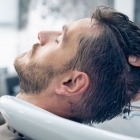The 5 Most Effective Ways to Regrow Thinning Hair

At the first sign of hair loss—or even before that, if you’re proactive—you should visit your board-certified dermatologist to discuss the latest and most effective retention and prevention tactics. (Assuming you want to keep your hair, that is.) There are numerous options available to men now, and they each have extremely high success rates. We tapped our network of experts to get their opinions on the most common methods. Before we get into them, here’s what some of those board-certified dermatologists have to say about the road ahead.
1. Start Early
“We know the best chance to regrow, retain, and fortify hair is with early intervention,” says Robert Finney, M.D. of Heights Dermatology and LaserOpens a New Window.. “If you start to notice thinning, that’s when you should begin treatment. Don’t be in denial.” The longer you wait, the less effective results are: “Men who begin to notice a bit of early thinning with hair loss starting at the vertex of their scalp, but who aren’t completely bald, have the best chance to slow down loss, halt loss altogether (by maintaining their hair density), and even regrow some or all of their hair,” says Laura Haygood, M.D., of Adagio Dermatology & AestheticsOpens a New Window.. “This means the earlier you start, the better the results, in general.”
2. Recession Is an Exception
“A receding frontal hairline rarely responds to treatment,” warns Haygood. “Men may focus on regrowing hair along the entirety of the frontal, crown, and vertex of the scalp.” The vertex is that transition point between the crown and midscalp.
3. Be Patient
“Whichever hair treatment you choose, it’s important not to give up on the treatment too quickly and stick with it for at least 3-6 months,” says Lindsey Yeh, M.DOpens a New Window.. It takes time for hair to grow and actually see changes. You’re playing a long game (forever, even): “Once you notice improvement, you must maintain the treatment regimen to retain these results,” Haygood adds. “So, if and when you decide to stop treatment, the hair simply gradually reverts to the density it would have otherwise been at that point in your life.”
The 5 Best Methods to Regrow Hair
1. The Pill
One of the most common means of regrowing hair is a 1mg prescription of finasteride. (That’s its generic name. You may know it as Propecia.) It inhibits the production of dihydrotestosterone (DHT), which gradually suffocates and shrinks hair follicles, causing hair to thin and fall away before the follicle dries up.
2. The Potion
The other at-home option you hear about most often is minoxidil, the generic for Rogaine. It works by stimulating blood circulation to hair follicles, which in turn fattens the hair shaft and strengthens the follicle. It’s administered as a topical solution or foam twice daily. “One tip I share with patients is that there are special compounding pharmacies (often the Mom & Pop pharmacies we love, rather than the big chain pharmacies) who are happy to provide an even stronger version,” says Haygood. “Many of my patients like the 7% minoxidil, although in the end I recommend choosing based on cost, convenience, and how the product feels on your skin, especially since you’ll be using it on a daily basis.”
3. The Plasma
In the last couple years, platelet-rich plasma (PRP) has grown enormously in popularity. It involves extracting one’s own blood, separating the plasma (which takes 10 minutes, in office), then injecting that plasma back into the patient’s scalp. Plasma has active growth factors that can stimulate inactive or weakened follicles. It’s also a common combination therapy method, paired with finasteride, minoxidil, or both. “PRP is my favorite treatment for hair growth, and studies show 75 percent of men see [significant] hair growth,” says Anna Karp, D.O. of Skin Institute of New YorkOpens a New Window.. “I recommend two treatments, one month apart, at minimum.” (Many doctors will advocate for 4 monthly treatments out the gate, followed by an annual top-off.)
“PRP is natural and doesn’t require patients to remember to do anything at home,” says Finney. “It’s a much newer treatment, but has proven over the last several years to be a great option to regrow, retain, and fortify.”
4. The Program
An effective at-home supplement and grooming regimen can also fortify hair and help revive some of the weakened, near-death follicles. It’s important to note that these are not nearly as promising as the above methods, but supplements are also no gimmick: They provide the nourishment your hair needs to stay strong. So, perhaps it’s as much a prevention and proactive method.
5. The Procedure
If all else fails, or if those patches are just too far along, it might be time to consider a hair transplant—if you’re that invested in this process. Talk to your doctor about the best options available, and for his or her recommendation on where to do it. This should really be a last resort, since results vary drastically. Know that emerging technologies are suggesting we may soon be able to clone hairs and grow them anywhere we please. But in the meantime, this method extracts thicker hairs from the sides and back of your head, and places them in areas of inactive growth to “fill in” the hair. It takes a while to see results, too: After a couple months, the transplanted hair will fall out, only to begin its first new growth cycle. So, once that springs out and fills in, it could take 4-6 months to see lasting results (albeit temporary ones, if you aren’t proactive about retaining it this go around).


